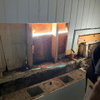Cracks in Plaster Ceiling
scoutjr
17 years ago
Related Stories

WALL TREATMENTSSurface Smarts: Venetian Plaster
Centuries-old Venetian plaster has made a roaring comeback in modern interiors. Could this old-world wall favorite work in your home?
Full Story
BATHROOM TILEQuick Fix: Repair Cracked Bathroom Grout
Banish an eyesore and safeguard your bathroom from water damage in 30 minutes or less with this DIY repair
Full Story
POOLSPlaster Tops Popularity List for Pool Finishes
Classic white or dyed to suit a mood, plaster is the most common and affordable finish for pools today
Full Story
REMODELING GUIDESRenovation Detail: Tongue and Groove Ceilings
As camouflage for damaged surfaces or simply for their rich texture and beauty, tongue and groove ceilings create high impact
Full Story
MOST POPULARHeads-Up Hues: 10 Bold Ceiling Colors
Visually raise or lower a ceiling, or just add an eyeful of interest, with paint from splashy to soothing
Full Story
COLORAdd Excitement With Vibrant Ceiling Color
Slather on some bold ceiling color for an instant — and eye-catching — transformation
Full Story
TASTEMAKERSCatch the Intrepid Design Spirit, Courtesy of Brian J. McCarthy
Crack open the designer's new book and discover how to create interiors that 'crackle with excitement'
Full Story
HOUZZ TOURSHouzz Tour: Industrial-Modern Studio in Slovakia
Cement ceilings and exposed brick walls form a backdrop for efficient storage and modern furniture in a Central European studio
Full Story
CEILINGSAdd a Touch of Elegance With a Ceiling Medallion
Installed with adhesive and often less than $100, this decorative detail makes an impact
Full Story
DECORATING GUIDESLook Up and Dream: 11 Ideas for an Inspired Ceiling
Think beyond the standard coat of paint, and make your ceiling pop with unexpected materials and glamorous finishes
Full StoryMore Discussions









ericwi
brickeyee
Related Professionals
Camarillo Kitchen & Bathroom Remodelers · South Barrington Kitchen & Bathroom Remodelers · Tulsa Kitchen & Bathroom Remodelers · Mountain Top Kitchen & Bathroom Remodelers · Bremerton General Contractors · Merrimack General Contractors · Montebello General Contractors · Solon General Contractors · Centennial Painters · Buckhall Painters · Greatwood Painters · Montclair Painters · Newport Beach Painters · Southbridge Painters · West Jordan Painterschris_ont
ezra
brickeyee